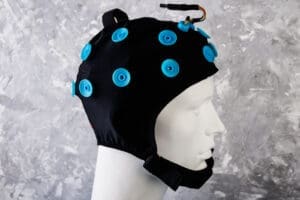
Harnessing Your Brain's Potential
Imagine having the ability to fine-tune your brain’s performance, much like a musician tunes an instrument. This isn’t science fiction—it’s neurofeedback, a groundbreaking approach to optimizing brain function and addressing a wide range of neurological conditions.
What is Neurofeedback?
Neurofeedback is a cutting-edge, drug-free method for addressing brainwave imbalances. This innovative technique, also known as EEG Biofeedback, utilizes real-time displays of brain activity to help individuals retrain their brainwave patterns. Think of it as a personal trainer for your brain, guiding it towards more balanced and efficient performance.
The Science Behind the Magic
At its core, neurofeedback is a learning modality designed to transform dysregulated brainwave patterns into more organized and efficient ones. By providing real-time feedback on brainwave activity, individuals can learn to alter their typical EEG patterns to achieve a more focused and attentive state.
A Time-Tested Approach
With a history spanning over thirty years, neurofeedback has been rigorously studied and refined. Its noninvasive nature and approval by the Food and Drug Administration as a safe procedure make it an attractive option for those seeking alternative treatments.
The Power of Neurofeedback: Conditions It Can Help
Scientific research has demonstrated the efficacy of neurofeedback in managing a wide array of neurological conditions. If you’re struggling with any of the following, neurofeedback might be the solution you’ve been searching for:
- Attention Deficit Hyperactivity Disorder (ADHD)
- Anxiety disorders
- Panic attacks
- Migraine and tension headaches
- Insomnia
- Chronic pain
- Post-stroke syndrome
Understanding Your Brain's Symphony: The Four Brainwaves
To truly appreciate the power of neurofeedback, it’s essential to understand the four distinct brainwaves that orchestrate your mind’s functions:
 Beta Waves: These are your brain’s “alert” waves, active when you’re focused and externally engaged.
Beta Waves: These are your brain’s “alert” waves, active when you’re focused and externally engaged.- Alpha Waves: Think of these as your “relaxation” waves, predominant when you close your eyes and unwind.
- Theta Waves: These brief waves occur as you begin to drift off to sleep, bridging wakefulness and slumber.
- Delta Waves: The deep sleep waves, active when you’re in restorative slumber.
When these brainwaves fall out of balance, various symptoms can manifest, depending on which waves are affected.
Delta/Theta Imbalance Symptoms
An imbalance in Delta or Theta waves can lead to:
- Cognitive impairment

- Impulsivity and hyperactivity
- Focus and attention issues
- ADHD symptoms
- Social inappropriateness
- Easy distraction
- Excessive speech
- Disorganization
- Hyper-emotional states
- Symptoms associated with traumatic brain injury
- Learning disorders
Alpha Imbalance Symptoms
When Alpha waves are out of sync, you might experience:
- Depression

- Victim mentality
- Excessive self-concern
- Passive-aggressive behavior
- Irritability
- Avoidance behavior
- Rumination
- Anger
- Self-deprecation
- Agitation
- Withdrawn behavior
Beta Imbalance Symptoms
A Beta wave imbalance can manifest as:
- Anxiety

- Obsessive-Compulsive Disorder (OCD)
- Migraines and tension headaches
- Insomnia
- Obsessive thinking
- Excessive rationalization
- Poor emotional awareness
- Panic attacks
- Chronic worry
- Chronic pain
- Hyper-vigilance
- Restlessness
The Brain's Remarkable Ability to Change: Neuroplasticity
One of the most exciting aspects of neurofeedback is its foundation in neuroplasticity—the brain’s ability to reorganize itself and form new neural connections throughout life. This means that regardless of your age, your brain can learn adaptive patterns and improve its function.
Neurofeedback takes advantage of this incredible plasticity, helping to reshape brainwave imbalances and create healthier pathways. The result? Enhanced brain function and improved quality of life.
Your Neurofeedback Journey: What to Expect
Step 1: The QEEG Evaluation
Your neurofeedback journey begins with a Quantitative Electroencephalogram (QEEG) evaluation. This sophisticated assessment tool objectively analyzes and records your unique brainwave patterns.
begins with a Quantitative Electroencephalogram (QEEG) evaluation. This sophisticated assessment tool objectively analyzes and records your unique brainwave patterns.
During the QEEG, you’ll wear a cap embedded with 12 small sensors that measure your brain’s electrical activity. Don’t worry—these sensors only record signals; they don’t transmit any electrical current into your brain.
Step 2: The QEEG Report
 After the evaluation, your data is compared to an extensive normative database, generating a comprehensive report. This crucial step allows your clinician to identify any brainwave imbalances and develop a personalized training protocol tailored to your specific needs.
After the evaluation, your data is compared to an extensive normative database, generating a comprehensive report. This crucial step allows your clinician to identify any brainwave imbalances and develop a personalized training protocol tailored to your specific needs.
Step 3: The Training Sessions
Neurofeedback training sessions take place in a comfortable, safe, and often entertaining environment. Here’s what you can expect:
- You’ll be connected to a
 computer using non-invasive, painless sensors.
computer using non-invasive, painless sensors. - These sensors will transmit your brainwave activity to the computer for recording and analysis.
- Your psychologist will monitor this data in real-time.
- You’ll choose a training medium—this could be a game, movie, TV show, music, or musical tones.
- Proprietary software will use your chosen medium to provide feedback when your brainwaves reach optimal patterns.
In essence, you’re learning to control the training medium with your brain. This process drives the formation of new neuropathways, leveraging neuroplasticity to help you incorporate these new skills into your everyday life.
Your Next Step: Discover the Benefits of Neurofeedback
Are you ready to unlock your brain’s full potential? We invite you to explore whether neurofeedback could be the solution you’ve been seeking. While neurofeedback has shown remarkable results for many, it’s important to remember that, like any treatment, it may not be suitable for everyone.
To determine if you or a loved one would be a good candidate for neurofeedback, we encourage you to reach out to the offices of Ginny Estupinian Ph.D. Our expert team will evaluate your specific situation and help you make an informed decision about your brain health journey.
Don’t let brainwave imbalances hold you back from living your best life. Take the first step towards optimizing your brain function today.
Call our office now to discover the benefits of neurofeedback for yourself:
844-802-6512
Embark on your journey to better brain health and unlock your mind’s true potential with neurofeedback!
Frequently Asked Questions
Our Services
Contact Us
We are here to answer your questions and guide you toward the best solution for your concerns. Call today or book online for an appointment.
Book Online Here
Some of the Research studies on the efficacy of neurofeedback
ANS Foundation Van der Kolk (91) 1/1/09-12/31/12 A pilot study examining the impact of neurofeedback on adults and adolescents with chronic post-trauma dysregulation.
Gapen, M., van der Kolk, B. A., Hamlin, E., Hirshberg, L., Suvak, M., & Spinazzola, J. (2016). A pilot study of neurofeedback for chronic PTSD. Applied psychophysiology and biofeedback, 41(3), 251-261.
Mark P. Jensen, Caroline Grierson, Veronika Tracy-Smith, Stacy C. Bacigalupi MA, Siegfried Othmer. (2008) Neurofeedback Treatment for Pain Associated with Complex Regional Pain Syndrome Type I, Pages 45-53 Journal of Neurotherapy Investigations in Neuromodulation, Neurofeedback, and Applied Neuroscience
Moriyama, T. S., Polanczyk, G., Caye, A., Banaschewski, T., Brandeis, D., & Rohde, L. A. (2012). Evidence-based information on the clinical use of neurofeedback for ADHD. Neurotherapeutics: The Journal of the American Society for Experimental NeuroTherapeutics, 9(3), 588–598.
Nestoriuc, Y., Martin, A., Rief, W. et al. Appl Psychophysiol Biofeedback (2008) 33: 125. https://doi.org/10.1007/s10484-008-9060-3
Nicholson, A. A., Ros, T., Frewen, P. A., Densmore, M., Théberge, J., Kluetsch, R. C., … Lanius, R. A., (2016). Alpha oscillation neurofeedback modulates amygdala complex connectivity and arousal in posttraumatic stress disorder. NeuroImage. Clinical, 12, 506–516.
Sokhadze, E. M., El-Baz, A. S., Tasman, A., Sears, L. L., Wang, Y., Lamina, E. V., & Casanova, M. F. (2014). Neuromodulation integrating rTMS and neurofeedback for the treatment of autism spectrum disorder: an exploratory study. Applied Psychophysiology and biofeedback, 39(3-4), 237–257.
Stokes, D. A, Lappin, M.S. Neurofeedback and biofeedback with 37 migraineurs: a clinical outcome study (2010) Behavioral and Brain Functions 6:9
Surmeli, T., & Ertem, A., (2009). QEEG Guided Neurofeedback Therapy in Personality Disorders: 13 Case Studies. Clinical EEG and Neuroscience, 40(1), 5–10. https://doi.org/10.1177/155005940904000107
Young, K. D., Zotev, V., Phillips, R., Misaki, M., Yuan, H., Drevets, W. C., & Bodurka, J. (2014). Real-time fMRI neurofeedback training of amygdala activity in patients with major depressive disorder. PloS one, 9(2), e88785
van der Kolk, B. A., Hodgdon, H., Gapen, M., Musicaro, R., Suvak, M. K., Hamlin, E., & Spinazzola, J. (2016). A Randomized Controlled Study of Neurofeedback for Chronic PTSD. PloS one, 11(12), e0166752. (2017 Award for outstanding contribution to science, Foundation for Neurofeedback & Applied Neuroscience)
 Beta Waves: These are your brain’s “alert” waves, active when you’re focused and externally engaged.
Beta Waves: These are your brain’s “alert” waves, active when you’re focused and externally engaged.


 computer using non-invasive, painless sensors.
computer using non-invasive, painless sensors.